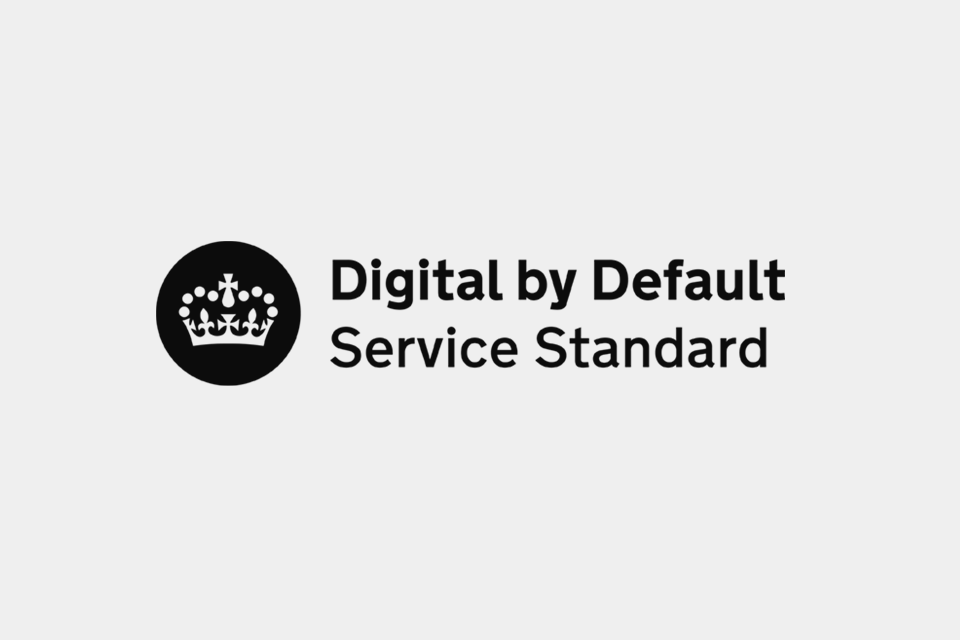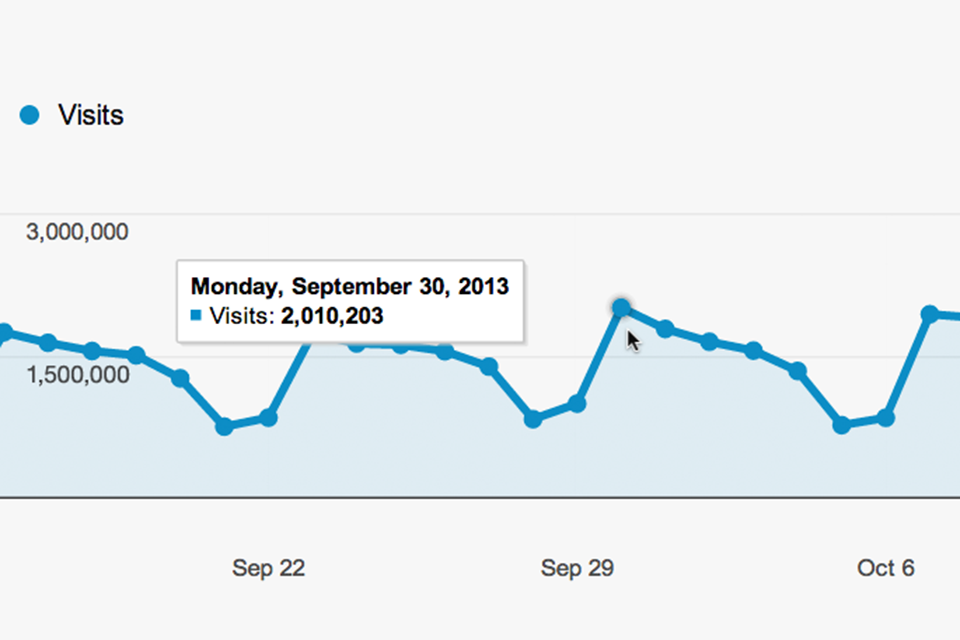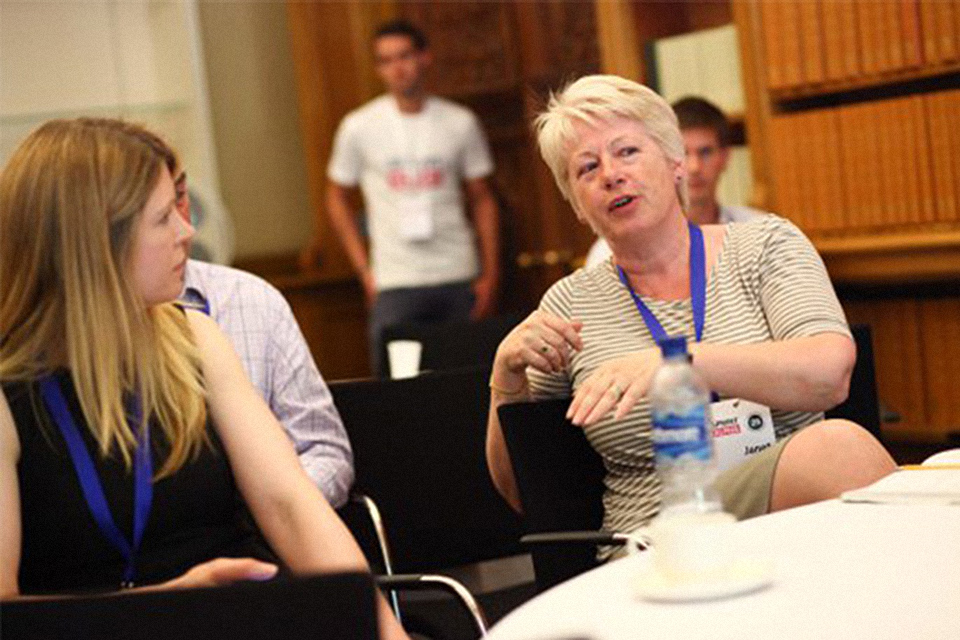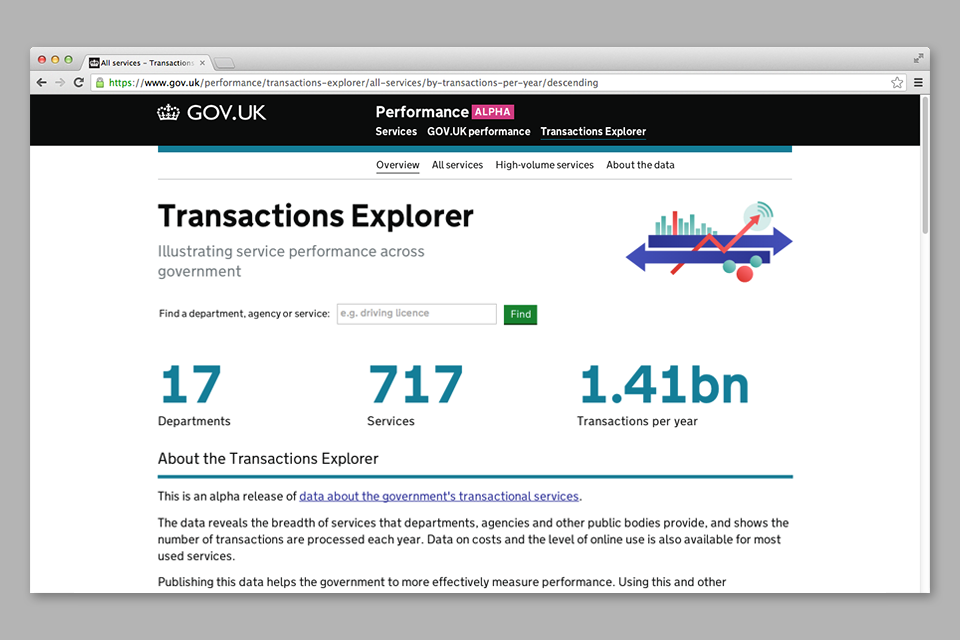Government Digital Strategy: quarterly progress report October 2013
Published 4 December 2013
The Government Digital Strategy was published in November 2012. It sets out 14 actions including: what we will do to create digital services so good that people will choose to use them, and support those who can’t; build digital capability across government; and use digital to improve policymaking.
Each department has its own digital strategy, setting out what it will do to respond to those 14 actions. Each quarter, we summarise our progress against the Government Digital Strategy. This is our third report; the first appeared in April 2013 and the second in July 2013 (a more detailed annual review will be published in December 2013).
Foreword by Mike Bracken: delivery and structural reform
This has been a rewarding and hugely challenging quarter for departments and GDS. Whilst hundreds of agencies gear up to migrate to the GOV.UK platform, our joint teams are making great improvements in transforming some of the most important government transactions.
Back at GDS, we’ve also had to face the challenge of growing our organisation and its supporting corporate services. We’re now starting to reap the rewards of making changes to our HR resources and centralising recruitment for all of government’s senior technology and digital roles. Helping HMRC attract Mark Dearnley as Chief Information and Digital Officer is an excellent example, and there are many more to come.
Similarly, our work on getting the right companies in to work with government has taken a huge amount of effort. G-Cloud continues to attract new suppliers, most of them SMEs, and great progress has been made on building the Digital Services framework which will be unveiled within weeks.
We’ve also been working with departments on much-needed changes to the technology function in government. Most of our focus has been on establishing the Office of the Chief Technology Officer and the Technology Leaders network as the engine for leadership, co-ordination and delivery of technology. These achievements mean huge and much needed change for the Civil Service, and rank among our most durable and strategic reforms.
Thanks to the joint working with colleagues across government, we can see real momentum on our ambitious delivery plan across 5 fronts - GOV.UK, service transformation, identity assurance, performance management and technology. As these changes take effect, and as delivery plans for transactions and identity start to turn into outcomes for end users, the importance of the work government has done this quarter will become much clearer.
Summary
There’s more detail in the report below, but in brief, in quarter 3 (July to September 2013), we:
- helped departments find specialist digital and technology staff from inside and outside government through the Government Digital Service (GDS) Recruitment Hub; we advised a further 2 of the 7 major transactional departments on organisational design; and supported departments on recruiting 20 digital specialist posts across 7 departments, and 9 Senior Civil Servant-level technology roles
- established a pool of specialist technology experts to provide skilled people for short-term deployment into departments and projects on a temporary basis
- took our Service Manager induction and development programme live, and started work with government professions to integrate digital into their capability plans, moved 20 agency and arm’s length body websites to GOV.UK, and provided user needs training to 80 lead editors across 35 organisations
- continued work on all 25 exemplar services; by the end of September, 1 service had elements already live, 11 were in beta, 6 were in alpha, and discovery was completed for the remaining 7 exemplars
- ran the Sprint Alpha event to share what’s been learned on the exemplar projects
- invited suppliers to help us deliver the digital agenda through a new procurement framework
- created an online library of best practice case studies to help departments with digital policy-making
- set up the new digital inclusion team within GDS, and started work on a digital inclusion strategy and on identifying opportunities for partnerships between the public, private, voluntary and community sectors to help people get online
- proposed a new operating model for government technology, sent to technology leaders across government. There was an excellent response, with over 30 detailed returns from 13 departments
- as part of this, set up a new Technology Leaders network which will hold its first meeting in October
- established Common Technology Services (CTS) as part of the Office of the Government Chief Technology Officer (OCTO). CTS will provide common IT products and services needed by all departments, to help them focus on their own mission IT applications
- adopted the first open standards for government
In quarter 4 (October to December) we expect to:
- move 5 exemplars from discovery to alpha, and at least 1 more service into public beta
- run a further Sprint event outside London to continue the process of sharing exemplar learning and experience
- begin publishing our Service Standard assessment reports
- run the first project for Cabinet Office Technology Transformation; this will shape the common service design and operating model and showcase better approaches to IT projects, not just better technology. Pilots will be running by December
- establish the Crown Hosting Service (CHS), targeting legacy hosting requirements. We will be working with departments to submit an outline business case in December
- hold the first meeting of our new Technology Leaders network and seek endorsement for our revised (beta) technology operating model
- migrate 14 more agency and arm’s length body websites to GOV.UK; and provide training for 70 lead editors from 30 organisations on user needs, and content editors from 35 organisations on web writing, style and publisher tools
- ask Digital Leaders to agree the addition of further actions to the Government Digital Strategy, including a requirement to support a cross-government approach to digital inclusion
- make the Digital Services framework available for use during November
- launch the new Identity Assurance reference hub in private beta from November, spearheaded by two exemplar services; Her Majesty’s Revenue and Customs (HMRC) PAYE Online service and Driver and Vehicle Licensing Agency (DVLA) driving licence details service
- release a prototype dashboard to measure policy performance, and make it possible for third parties to develop dashboards on our Performance Platform
- set up a new world-class user testing laboratory
- work with Her Majesty’s Treasury (HMT) to publish revised guidance on writing business cases for agile projects
- put forward proposals to build digital skills across government; and contribute to a digitally-themed induction event for newly appointed Senior Civil Servants in October
Digital capability and leadership
Service Managers alpha, Aviation House, 5 June 2013
The Civil Service Capabilities Plan, published in April, identified digital capability as a high priority. When we say “digital capability,” we mean having civil servants who truly understand the internet and technology, and how they can be used to make government policy and digital services better.
- advising on recruitment of senior people with the right digital and technology skills, and integrating those roles with the rest of the team; for example, defining the structure and roles for Department for Work and Pension’s (DWP) digital services division and helping recruit people for them, and advising Ministry of Justice (MOJ) on recruitment plans for SCS roles
- responding to departmental requests for help in recruiting 9 senior level posts across government; and 20 other specialist digital roles in 7 departments
- running a beta of the Service Manager induction and development programme in July and building on that to launch a full live programme in September
- starting to work with the main professions in the civil service, particularly the Operational Delivery profession (which covers around 70% of all civil servants), to further embed digital skills in their roles
- working with the Government Communications Network on their review of digital communications
- bringing responsibility for the Technology in Business (TiB) fast stream into GDS
- holding an alpha digital learning day at Manchester TechHub, run by a fast streamer from the TiB fast stream
Three departments - Cabinet Office (CO), Department for Communities and Local Government (DCLG), and Home Office (HO) - have appointed new Digital Leaders during the quarter.
More departments have made progress in building capability:
- DWP digital division has approval to recruit 18 specialist roles to work on its exemplars
- Department for Education (DfE) has structured its digital division into teams aligned to digital services transformation, migration to GOV.UK, and user insight and analytics
- Department of Health (DH) has created a new Informatics and Digital Services division to bring together information strategy and policy, digital leadership and portfolio management for DH and ALB digital services. Digital communications and engagement remains within Communications but both sections work closely together as part of the wider DH Digital team
Other departments including CO and Department for International Development (DFID) are beginning to look at setting up new roles or repurposing existing staff job descriptions. DFID has also introduced digital expertise at board level and is setting up a digital advisory panel.
Following the transfer of responsibilities from the former government CIO to GDS, we formed the Office of the Chief Technology Officer (OCTO) within GDS. We carried out a review of the technology operating model, and published an early version (alpha) for feedback from technology leaders across government last quarter. There was an encouraging response, with over 30 detailed returns from 13 departments. The main proposition - to close existing boards and instead create a Technology Leaders network - was endorsed by the Digital Leaders network.
We will be running the first Technology Leaders meeting in October, and will incorporate the feedback into a revised operating model (beta) which will be presented to technology leaders for their approval.
Departments continue to promote digital in their own training and development programmes. For example, Department for Business Innovation and Skills (BIS) held a Digital Fortnight in September, covering open policy making, service transformation, agile, digital engagement, and sessions for staff who want to learn how they can use digital in their work. DH has worked with its HR team to include digital within the fast-stream induction for its new cohort, with a view to incorporating digital into the corporate induction programme for all DH staff.
Service design and operation - best practice guidance and advice

The Government Service Design Manual, published in mid-April, aims to help departments achieve the Digital by Default Service Standard. GDS has begun looking at other ways to share and disseminate best practice; for example, by establishing a wider range of specialist digital communities to support service transformation and publishing.
Meeting the Standard will be mandatory for all new and redesigned services handling over 100,000 transactions each year from April 2014. Initial assessment against the Standard has already started for new services applying to be made available via GOV.UK, looking at each service’s:
- fit with user needs
- capacity to develop and improve
- compliance with information security requirements.
12 assessments were undertaken this quarter, all but one of which were seeking progression between alpha and beta stages of development. 5 services were approved to proceed (subject to meeting certain requirements), 3 of these to public beta. Services needing to make further improvements before coming back for reassessment are given detailed feedback on what they should work on to achieve a pass.
Service transformations
Sprint Alpha Transformation Demo
The Government Digital Strategy required major transactional departments to identify ‘exemplar’ services for transformation. We have begun work on all 25 exemplar projects. Progress has been good; by the end of September, 1 service had elements already live, 11 were in beta, 6 were in alpha, and discovery was complete for the remaining 7 exemplars.
The services in public beta by the end of this quarter are lasting power of attorney, employment tribunal fees and probate search.
Now all projects have completed discovery, we will draw up a delivery plan for each service and will form a delivery approach for the overarching GDS programme that will support this.
We continue to encounter issues across the programme including challenges to new ways of working presented by traditional procurement approaches; and integrating agile projects into broader programmes managed using traditional ‘waterfall’ project management methods. We have set up a forum of Digital Leaders from the departments with exemplar projects to begin addressing these concerns.
We want to make sure we learn from the transformation work. We’re looking at how organisational structures and culture need to adapt, alongside improving staff skills. To do this, GDS has developed an approach to assess capability within exemplars. We will help exemplar services and departments work through this over the next quarter. Outcomes will be fed back to those involved by December. They will also be used to inform future capability building initiatives; both in the teams and departments involved, and potentially more widely across the civil service.
We also ran Sprint Alpha, an event intended to showcase and share learning between those working on digital transformation. This was attended by ministers and permanent secretaries, demonstrating their keen interest in the potential of digital to improve services and increase efficiency.
We are working with Her Majesty’s Treasury (HMT) to refine the business case approval process, to make it work better with agile project delivery. We expect updated guidance to be published in the next quarter.
We have published guidance on increasing digital take-up and we are working with a number of departments, agencies, and other public sector bodies to identify practical examples of how these organisations have successfully achieved channel shift. For example, DWP Jobseeker’s Allowance online claims increased to 82% in August 2013, up from 32% the year before. The service now sees an average of around 5 million online job searches each day. We will add to or update these case studies as we learn about more good examples, and improve the guidance in line with user feedback. Both DfE and HMRC are working on channel shift strategies involving their executive agencies and frontline services.
The assisted digital team is working with exemplar services using the Assisted Digital Action Plan in the Service Manual. Examples are:
- the Department for Environment Food and Rural Affairs (Defra) CAP Delivery Programme is working with specialist farming bodies and organisations who currently help users get online, to fully understand their users’ needs
- MOJ’s lasting power of attorney exemplar team is working with a range of third party organisations and charities on small scale pilots, running alongside the public beta of the digital service
- DVLA is testing a ‘view driving record’ exemplar digital service with non-internet users, and has made changes based on their feedback. This testing is helping them map out the user journey for those who may need some form of support
- HMRC has established dedicated assisted digital support resources to cover its four exemplars, in addition to the core digital transformation team for each area. Capturing assisted digital user insight is included within the departmental research plan for 2013 to 2014
GDS has begun a project with the Helen Hamlyn Centre for Design on how assisted digital support can meet the needs of older people. The project has helped GDS to gain understanding about the reasons why older people are completely or partially offline, and with exploring potential design solutions.
Service redesign is not confined to exemplars; other departments are transforming services too. For example, DfE has a range of work underway, including:
- improvements to the DfE Academies and Free Schools Online Application, the process used for schools to convert to academy status, to make it simpler, shorter and less staff-intensive; an alpha will be released in October
- replacing 9 disparate and inconsistent secure services used by the Education Funding Agency (EFA) to exchange funding information with thousands of schools and 152 local education authorities
- adopting an improved form builder tool to meet user needs in a secure and efficient way for the 40 or so forms used by the department; the first forms should be ready in October
GOV.UK
All departments have now moved their corporate information publishing across to GOV.UK. A new version of the GOV.UK homepage went live on 27 July, alongside improvements to the search tool and Inside Government.
We worked with colleagues from the NHS, Department for Transport, Department for Health and the Cabinet Office’s Behaviour Insights team to run experiments to learn how GOV.UK might increase the numbers of people choosing to register as organ donors. One small change to a page on GOV.UK has led to around 10,000 additional people joining the organ donor register each month, meaning it’s now the third biggest source of new registrations, behind doctors’ surgeries and the DVLA.

On Monday 30 September GOV.UK had its busiest day ever with 2,010,203 visits, passing 2 million for the first time. Popular topical content included the Royal Mail Share Offer, the Help to Buy scheme, National Minimum Wage rates increasing, and the usual end-of-month car tax renewals.
Since launch in October 2012, GOV.UK has handled over 1 billion page views from 150 million unique devices.
By the end of September, 20 out of around 330 agency and arm’s length body sites had been moved across; see our transition blog for more details.
To support the transition, GDS is providing user needs training to these organisations. By the end of September, around 80 lead editors had been trained. Plans are being put into place to extend this programme. In addition, we’re planning ways of building a network of super-editors and champions to support the wider group and ensure momentum is sustained.
Digital inclusion

Following the BIS release of the Information Economy Industrial Strategy to boost growth opportunities for digital industries, a new cross-government team has been established in GDS to help people, businesses and charities get online. It has begun to:
- draft a digital inclusion strategy setting out the nature of the challenge, the scale of government’s ambition and an action plan for delivering it
- act as a central point for collaboration on digital inclusion, working with government and non-government partners on various initiatives
- build knowledge on ‘what works’ in digital inclusion, to use for planning and evaluating future work
Other government-wide initiatives supporting departmental digital work

The Open Standards Board has recommended the approval of the first open standards for government technology, based on advice from specialist advisory panels and peer review. These will be adopted as the first open standards for government.
The Identity Assurance Programme is working with 9 central government departments and over 20 services, as well as with other public service providers. There is also developing interest from other market sectors including mobile and financial services.
In early September, 5 of the Identity Providers on the cross-government identity assurance framework (Digidentity, Experian, Mydex, The Post Office, and Verizon) signed contracts to deliver our first live services.
The public consultation for the draft Identity Assurance Principles produced by the Identity Assurance Programme’s Privacy and Consumer Advisory Group closed in September. Responses will be reviewed by the Group’s members and updated Principles will be produced before the end of 2013.
To support better procurement for digital services, on 9th July we invited suppliers to help us deliver our digital agenda. Applications closed on 7 August. The response from the market was excellent; we received 1,623 responses from 280 companies (87% of them SMEs) across the 8 digital capabilities listed. Due to the high numbers, the supplier evaluation phase is being extended and we expect the Digital Services framework to be available for use during November.
Common platforms continue to be developed and extended:
- following a new release in mid-September, the Transactions Explorer now covers 711 services. Of these, 83 are high-volume services, and we have additional information on cost per transaction and digital take-up for 63 of them. We also now have data on some of the exemplar services undergoing transformation. Department of Health (DH) data is included for the first time; about 45 of its services are listed at present including some large volume NHS-to-citizen transactions, but this figure will increase as more of its arm’s length bodies participate
- there are now 9 services with detailed dashboards live on the Performance Platform, covering 3% by volume of all transactions, including services from DVLA, DCLG and Foreign and Commonwealth Office (FCO)
Departments are exploring the use of digital tools to engage with the public and to improve policy-making. For example, FCO consular staff are now directly responding to questions from British nationals about travel overseas via the @fcotravel twitter channel, and DWP is launching a range of social media channels.
GDS facilitated policy workshops with MOJ and DCLG to give policy makers the opportunity to explore digital tools and design techniques that could support more responsive policy-making.
In August, in association with Demsoc, we released the Matrix – a repository of open policy-making case studies and digital tools. The case studies outline the experiences and lessons learnt by civil servants who are applying open policy-making principles, describe the digital tools that enable them, and can be filtered by a range of criteria to increase relevance.
The Policy profession ran an update around digital awareness during August. At a departmental level, HO made open and collaborative policy-making a key theme of their Advanced Policy Week in September, as did BIS in its Digital Fortnight staff development initiative; DH has run a series of successful workshops and drop-in sessions for its press team, has developed a plan for building capability at senior levels, and is currently rolling out a training schedule for all policy teams; and FCO introduced a “Core Policy Skills – Digital Diplomacy” course geared at explaining to policy officials how it can use digital tools to enhance its work.
Departments agreed to highlight any legislative barriers that would obstruct the development of digital processes and services. So far only a few have been identified, such as the requirement for a ‘wet signature’ to authorise the completion of a range of services. Departments are assessing the impact of these and exploring potential solutions.
